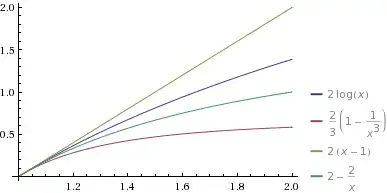Generalities
The problem has spherical symmetry, so it makes sense to use spherical coordinates ($r$, $\theta$, $\phi$). We can divide the vessel into differential elements like the one shown in this post.
Deformation and strain
Only radial deformations are allowed by the spherical symmetry, so let's parametrize the deformation by
$$r \rightarrow r + u(r)$$
Assuming small deformations:
$$dr \rightarrow dr(1 + u'(r))$$
$$r\,d\theta \rightarrow (r + u(r))\,d\theta$$
$$r\cos\theta\,d\phi \rightarrow (r + u(r))\cos\theta\,d\phi$$
The associated strains:
$$\epsilon_{rr} = \frac{dr(1 + u'(r)) - dr}{dr} = u'(r)$$
$$\epsilon_{\theta\theta} = \frac{(r + u(r))\,d\theta - r\,d\theta}{r\,d\theta} = \frac{u(r)}{r}$$
$$\epsilon_{\phi\phi} = \frac{(r + u(r))\cos\theta\,d\phi - r\cos\theta\,d\phi}{r\cos\theta\,d\phi} = \frac{u(r)}{r}$$
Symmetry
By spherical symmetry we have:
$$\epsilon_{\theta\theta} = \epsilon_{\phi\phi} = \epsilon_{tt}$$
$$\sigma_{r\theta} = \sigma_{r\phi} = \sigma_{\theta\phi} = 0$$
$$\sigma_{\theta\theta} = \sigma_{\phi\phi} = \sigma_{tt}$$
$$\frac{\partial\,\sigma_{rr}}{\partial\,\theta} = \frac{\partial\,\sigma_{\theta\theta}}{\partial\,\theta} = \frac{\partial\,\sigma_{\phi\phi}}{\partial\,\theta} = \frac{\partial\,\sigma_{rr}}{\partial\,\phi} = \frac{\partial\,\sigma_{\theta\theta}}{\partial\,\phi} = \frac{\partial\,\sigma_{\phi\phi}}{\partial\,\phi} = 0$$
Equilibrium condition
The equilibrium condition can be expressed in spherical coordinates as
$$2\sigma_{rr} + r\frac{\partial\,\sigma_{rr}}{\partial\,r}-\sigma_{\theta\theta}-\sigma_{\phi\phi} = 0$$
or, using the symmetry conditions,
$$2\sigma_{rr}(r) + r\sigma_{rr}'(r) - 2\sigma_{tt} = 0$$
Hooke's law
Applying Hooke's law for isotropic materials we get
$$\epsilon_{rr} = \frac{1}{E}(\sigma_{rr} - 2 \nu \sigma_{tt})$$
$$\epsilon_{tt} = \frac{1}{E}(\sigma_{tt} - \nu (\sigma_{rr} + \sigma_{tt}))$$
where $E$ is the elastic modulus and $\nu$ is the Poisson's ratio.
Math
Combining the previous results we get the following equations:
$$u'(r) = \frac{1}{E}(\sigma_{rr} - 2 \nu \sigma_{tt})$$
$$\frac{u(r)}{r} = \frac{1}{E}(\sigma_{tt} - \nu (\sigma_{rr} + \sigma_{tt}))$$
$$2\sigma_{rr}(r) + r\sigma_{rr}'(r) - 2\sigma_{tt} = 0$$
From there we can get the following differential equation for the deformation (by a tedious but quite straightforward path):
$$2 u'(r) - 2 \frac{u(r)}{r} + r\,u''(r) = 0$$
From there, it's easy to get
$$u(r) = A\,r + \frac{B}{r^2}$$
and, as a consequence,
$$\sigma_{tt} = E \frac{A}{1 - 2\nu} + E\frac{B}{1 + \nu}\frac{1}{r^3}$$
$$\sigma_{rr} = E \frac{A}{1 - 2\nu} - 2 E\frac{B}{1 + \nu}\frac{1}{r^3}$$
where $A$ and $B$ are integration constants determined to be consistent with the boundary conditions.
Solving the original problem
The original problem has zero external pressure, internal pressure $P$, interior radius $R_i$ and exterior radius $R_o$. For continuity, we must have
$$\sigma_{rr}(R_i) = -P$$
$$\sigma_{rr}(R_o) = 0$$
Getting the constants from these boundary conditions:
$$A = \frac{P(1 - 2\nu)}{E}\frac{R_i^3}{R_o^3 - R_i^3}$$
$$B = \frac{P(1 + \nu)}{2 E}\frac{R_o^3 R_i^3}{R_o^3 - R_i^3}$$
Getting the stresses:
$$\sigma_{rr} = P\frac{R_i^3}{R_o^3 - R_i^3}\left(1 - \frac{R_o^3}{r^3}\right)$$
$$\sigma_{tt} = P\frac{R_i^3}{R_o^3 - R_i^3}\left(1 + \frac{1}{2}\frac{R_o^3}{r^3}\right)$$
